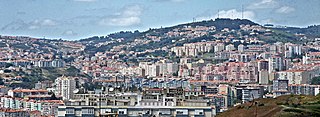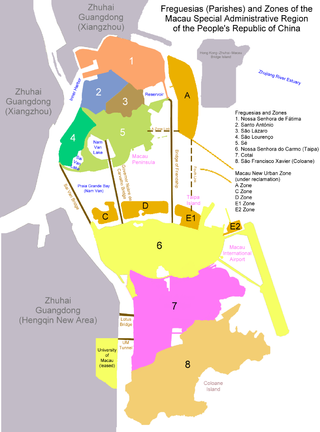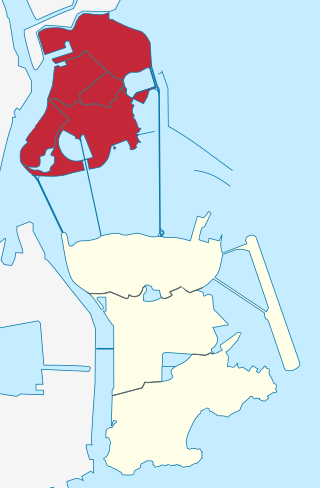
Caldas da Rainha is a medium-sized Portuguese city in the Oeste region, in the historical province of Estremadura, and in the district of Leiria. The city serves as the seat of the larger municipality of the same name and of the Comunidade Intermunicipal do Oeste. At the 2011 census, the municipality had a population of 51,729 in an area of 255.69 square kilometres (98.72 sq mi), with 30,343 residing in the city. Although the city itself lies about 10.5 kilometres (6.5 mi) inland, three of the municipality's civil parishes lie on the Atlantic Ocean. Caldas da Rainha is best known for its sulphurous hot springs and ceramic pottery.

Portugal is a unitary state with delegated authority to three levels of local government that cover the entire country:

Freguesia, usually translated as "parish" or "civil parish", is the third-level administrative subdivision of Portugal, as defined by the 1976 Constitution. It is also the designation for local government jurisdictions in the former Portuguese overseas territories of Cape Verde and Macau. In the past, was also an administrative division of the other Portuguese overseas territories. The parroquia in the Spanish autonomous communities of Galicia and Asturias is similar to a freguesia.
Concelho is the Portuguese-language term for municipality, referring to the territorial subdivision in local government. In comparison, the word município refers to the organs of State. This differentiation is still in use in Portugal and some of its former overseas provinces, but is no longer in use in Brazil following the abolition of these organs, in favour of the French prefecture system. It is similar to borough and council.

A câmara municipal is a type of municipal governing body, existing in several countries of the Community of Portuguese Language Countries.
An Assembleia Municipal is the legislature that governs a municipality in Portugal. Part of the assembly's members are elected every four years among candidate lists by the D'Hondt method, simultaneously with the election of the Câmara Municipal; the remainder member are the presidents of the Junta de freguesia that compose the municipality, whose number cannot exceed the number of elected members. A municipal assembly generally meets five times a year, and its members are paid a presence fee for each meeting.

The Lisbon Metropolitan Area is a metropolitan area in Portugal centered on Lisbon, the capital and largest city of the country. The metropolitan area, covering 18 municipalities is the largest urban area in the country and the 10th largest in the European Union, with a population in 2015 of 2,812,678 in an area of 3,015.24 km².

Odivelas is a city and a municipality in Lisbon metropolitan area, Portugal, in the Lisbon District and the historical and cultural Estremadura Province. The municipality is located 10 km northwest of Lisbon. The present Mayor is Hugo Martins, elected by the Socialist Party. The population in 2011 was 144,549, in an area of 26.54 km2 (10.25 sq mi).

By the end of Portuguese rule, Macau was administratively divided into two municipalities and seven civil parishes. Parishes were administrative subdivisions of the municipalities. After the 1999 handover to China, parishes are still officially recognized divisions but for symbolic reasons only.

Leça da Palmeira is a former civil parish in the municipality of Matosinhos in the Greater Porto area, Portugal. In 2013, the parish merged into the new parish Matosinhos e Leça da Palmeira. It has 5.97 km² and had 17.215 inhabitants in the 2001 census.

The Municipality of Ilhas was one of the two municipalities of Macau, along with the Municipality of Macau. Its organs were the municipal council and the municipal assembly. Per Law No. 17/2001, the two municipalities were abolished on December 31, 2001 and replaced by the Instituto para os Assuntos Cívicos e Municipais the following day.

The Municipality of Macau was one of two municipalities of Macau, along with the Municipality of Ilhas.

The territory of Cape Verde is divided into 22 concelhos (municipalities), and subdivided into 32 freguesias.
Pontinha, with an area of 4.64 km2, is a former civil parish in the municipality of Odivelas, Portugal. In 2013, the parish merged into the new parish Pontinha e Famões. It is on the periphery of the metropolitan area of Lisbon, District of Lisbon, within the NUTS III Region of Lisboa e Vale do Tejo.
Aguada de Baixo was a freguesia in Águeda Municipality, Aveiro District, Portugal. It had an area of 4.7 km2 and in 2011 had a population of 1373. In 2013 it was merged with Barrô as part of an administrative reorganization of the territory and formed the União das Freguesias de Barrô e Aguada de Baixo.
The assembleia de freguesia is the legislature of a freguesia, the local administrative unit LAU 2 of Portugal. The laws regulating the assembleias de freguesia are the Lei n.o 169/99, de 18 de Setembro and the Lei n.o 5-A/2002 de 11 de Janeiro. The number of members of each assembly is dependent on the number of registered voters in each freguesia ranging from 7 if there are 1,000 or less registered voters to 19 if there are over 20,000 and an increase of one member per 10,000 registered voters after 30,000.
Barrô was a freguesia in Águeda Municipality, Aveiro District, Portugal. It had an area of 7 km2 and in 2011 had a population of 1836.
Águeda was a freguesia in Águeda Municipality, Aveiro District, Portugal. It had an area of 41.6 km2 and in 2011 had a population of 11,346.
Belazaima do Chão was a freguesia in Águeda Municipality, Aveiro District, Portugal. It had an area of 19.8 km2 and in 2011 had a population of 599.












